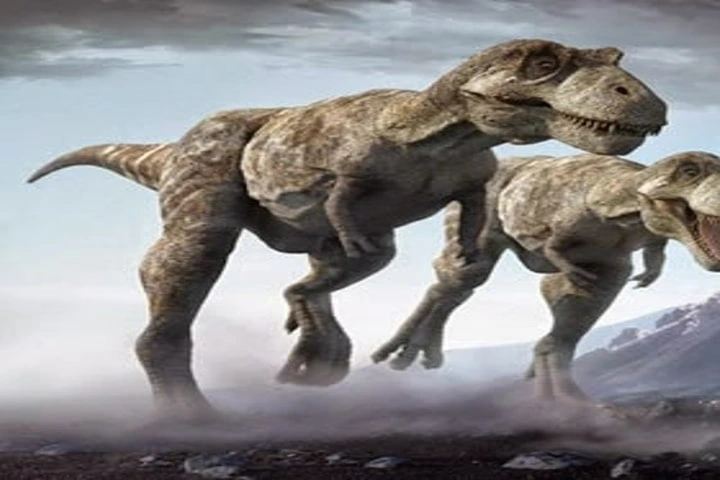

A new study suggests that even though T. rex short arms may look out of place, they evolved to ensure their safety during group eating (Pic. Courtesy Twitter/@Titanlizard_Art)
<p>
<strong>Sometimes an out of the box theory looks like a plausible explanation for something which seems bizarre. Take for example the small arms of the mighty and ferocious Tyrannosaurus rex which couldn&rsquo;t be clarified despite many suggesting that they were used as slashing machines or helped in grasping the partner during mating, as per a report in&nbsp;<a href="http://sciencealert.com/" target="_blank">sciencealert.com</a>.</strong></p>
<p>
Though it is really difficult to figure answers by looking at bones which are 66 million years old, a new study has come with a fresh hypothesis, which states that the short arms helped in bringing down the chances of accidental bites by other T. rex when these creatures indulged in eating frenzies. The smaller the size, the lesser were chances of it being bitten off!</p>
<p>
Elaborating on this new study, its author Kevin Padian, said: <a href="https://www.sciencealert.com/wild-study-suggests-that-maybe-t-rex-had-such-short-arms-so-their-friends-didn-t-eat-them?utm_source=ScienceAlert+-+Daily+Email+Updates&amp;utm_campaign=d375aa7023-MAILCHIMP_EMAIL_CAMPAIGN&amp;utm_medium=email&amp;utm_term=0_fe5632fb09-d375aa7023-366100389">&quot;What if several adult tyrannosaurs</a> converged on a carcass? You have a bunch of massive skulls, with incredibly powerful jaws and teeth, ripping and chomping down flesh and bone right next to you. What if your friend there thinks you&#39;re getting a little too close? They might warn you away by severing your arm. So, it could be a benefit to reduce the forelimbs, since you&#39;re not using them in predation anyway.&quot;</p>
<p>
Padian is from University of California, Berkeley and an integrative biologist.</p>
<p>
The fossil finds of skin and feathers have helped palaeontologists to have a better idea about how the dinosaurs looked while placement of their bones help in knowing what these creatures did and likewise footprints provide details about their habits.</p>
<p>
Yet despite this, questions which are complex and related to evolution are tough to answer. This is true even for those creatures whose conduct we can see and whose ancestors&rsquo; genomes we have access to.</p>
<p>
The T. rex which is 14 metre long and has a skull which is 1.5 metre but its arms are just a metre long. To understand it better through comparison, it is equivalent to a human being who is six foot tall and has arms which are five inches.</p>
<p>
<strong>Also read: <a href="https://www.indianarrative.com/science-news/million-years-ago-dinosaurs-survived-asteroid-strikes-but-perished-due-to-extreme-weather-on-the-planet-159747.html">66 million years ago dinosaurs survived asteroid strikes but perished due to extreme weather on the planet</a></strong></p>
<p>
In order to test his hypothesis, Padian used the measurements of a fossil specimen, MOR 555 which is the most complete one. With the help of these figures, he suggested that the earlier proposed theories about small arms &ndash; for mating and for use as slashing arms &ndash; are not likely as the arms are too weak and small to be of use.</p>
<p>
Padian instead puts forward the theory that tiny arms provided an evolutionary advantage &ndash; of keeping them out of the way while feeding in a group.</p>
<p>
In his paper Padian explained thus: &quot;Longer arms, especially in their natural, somewhat anteriorly extended orientation, would have brought them into the ambit of the deadliest jaws ever recorded on land. The danger of wounds, amputations, infections, disease and ultimate death&hellip;would have been a selective force for reduction, irrespective of relict functionality of the limbs.&rdquo;</p>
<p>
He added: &ldquo;Let us hypothesize, therefore, that the reduction of forelimb size was a secondary function of selection for something else. As such, we should not look for functionality in these reduced limbs, but for how that reduction served a larger purpose.&quot;</p>
<p>
This hypothesis, Padian said, can be collaborated by more studies on aspects like if there are relatively lesser bite marks on arm bones as compared to other parts of the body.</p>
<p>
Details of this research paper have been published in Acta Palaeontologica Polonica.</p>
Israel Defence Forces Spokesperson Brigadier General Effie Defrin on Thursday said that Iran has expressed…
India's Hindustan Aeronautics Limited (HAL) and French engine manufacturer, Safran Aircraft Engines, signed an agreement…
India has emerged as a country with the third-largest growth in power generation capacity globally…
Prime Minister Narendra Modi hailed Indian chess grandmaster Divya Deshmukh for defeating world number one…
The family of detained Baloch leader Mahrang Baloch has accused prison authorities at Quetta's Hudda…
The QS World University 2026 Rankings bring great news for our education sector, as the…